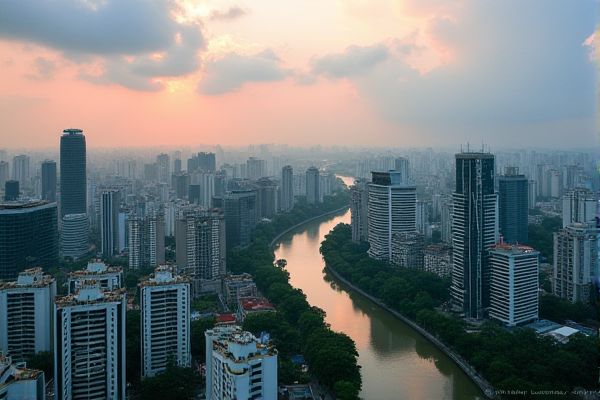
Cost of living in Vietnam: Affordable housing options available. Low cost of transportation. Inexpensive local meals. Budget-friendly street food. Affordable public healthcare. Cost-effective personal services. Electricity and utilities vary seasonally. High-quality imported goods are pricier. Affordable internet and mobile plans. Cost-effective domestic travel.
Affordable housing options available.
In Ho Chi Minh City, affordable housing options are severely limited, with apartments under VND 3 billion, considered affordable, accounting for only 18% of the new primary supply in the first half of 2024. The future affordable housing is expected to be mainly introduced in adjacent areas like Binh Duong due to the scarcity in the city itself. This shortage of affordable housing is a growing concern highlighted in detail by Savills Vietnam, which underscores the challenges and potential solutions facing urban development in the rapidly growing city.
Low cost of transportation.
Transportation costs in Vietnam are relatively low, with motorbike fuel costs ranging from $20 to $50 per month. Public transportation trips cost less than $1, and ride-hailing services like Grab typically range between $1 to $5 per ride. The [Average Cost of Living in Vietnam](https://asialegend.travel/understand-the-average-cost-of-living-in-vietnam/) provides valuable insights for anyone planning to move or travel to this vibrant country, highlighting affordable options for getting around.
Inexpensive local meals.
In Vietnam, inexpensive local meals, particularly street food, range from 1 to 4 USD per dish. Popular options like Banh Mi, Pho, and Bun Cha are available within this price range, making it possible for travelers to spend around 5-10 USD per day for three meals. This remarkable affordability allows visitors to explore the culinary delights of Vietnam without overspending. For those interested in learning more about the cost of dining while traveling in Vietnam, the Vietnam Food Price Guide provides detailed insights into various dining options and budgeting tips.
Budget-friendly street food.
In Vietnam, budget-friendly street food is highly affordable, with dishes like Banh Mi, Pho, and Bun Cha costing between $1 to $4 per dish, allowing travelers to have three meals a day for $5 to $10. Popular street food options include Banh Mi for $1-2, Pho for $1.5-3, and Bun Cha for $2-4, making it an excellent choice for budget-conscious travelers. For more details on these delicious options, check out the Food Price Guide in Vietnam, offering travelers valuable insights into local cuisine and pricing.
Affordable public healthcare.
Affordable public healthcare in Vietnam is limited due to underfunding and structural inefficiencies, which result in low quality of care, high out-of-pocket costs, and significant differences between urban and rural healthcare services. Despite efforts to provide universal healthcare, public hospitals are overcrowded, understaffed, and lack adequate medical equipment, making Private Healthcare a preferred option for many, especially expatriates.
Cost-effective personal services.
In Vietnam, cost-effective personal services are widely accessible, offering affordable housekeeping options such as a full-time, live-in maid for approximately $125 per month or a cleaning lady charging just $2 or $3 per hour. Moreover, gym memberships are budget-friendly, with an average cost of around $30 per month, making it easier to maintain a healthy lifestyle. Transportation services are also particularly affordable, with options including buses and motorbike taxis readily available. These aspects contribute significantly to the overall Cost of Living in Vietnam, making it an attractive destination for expatriates seeking both quality and affordability in everyday services.
Electricity and utilities vary seasonally.
The cost of electricity and utilities in Vietnam can vary, particularly with the use of air conditioning, which significantly impacts the electricity bill. On average, electricity costs range from $30 to $50 per month, while other utilities like water, garbage collection, and gas contribute to the overall utility costs. For more insights on these expenses and budgeting tips, you can visit the comprehensive guide on the Vietnam Living Cost Per Month, which explains the nuances of managing living expenses more effectively, ensuring you are well-prepared for life in Vietnam.
High-quality imported goods are pricier.
High-quality imported goods in Vietnam are generally more expensive due to factors such as import agent fees, customs duty, and value-added tax (VAT), making them pricier than local alternatives. For example, items like milk, cheese, and imported beer are significantly more costly than their local counterparts. For more detailed insights on this topic, you can visit the Cost of Living in Vietnam webpage, which provides an in-depth understanding of these cost discrepancies.
Affordable internet and mobile plans.
In Vietnam, internet services are affordable, with high-speed connections averaging Rs750 to Rs1,500 (approximately $9 to $18 USD) per month, and mobile phone services range from Rs300 to Rs750 (approximately $4 to $9 USD) per month, depending on usage and data requirements. For more information on the financial aspects of living in this vibrant country, you can visit the Cost of Living in Vietnam page. This resource provides an extensive overview of various expenses you may encounter, ensuring a well-planned stay or transition.
Cost-effective domestic travel.
For cost-effective domestic travel in Vietnam, consider using buses, trains, and ferries, with bus tickets ranging from $5 to $25, train tickets from $15 to $70, and ferry rides from $10 to $20. Domestic flights, though more expensive, can be affordable with promotional fares, often costing between $30 and $100 for a one-way ticket. For more details on budget-friendly travel options, you can visit the Vietnam Travel Cost page, which provides comprehensive information to plan your journey economically.
